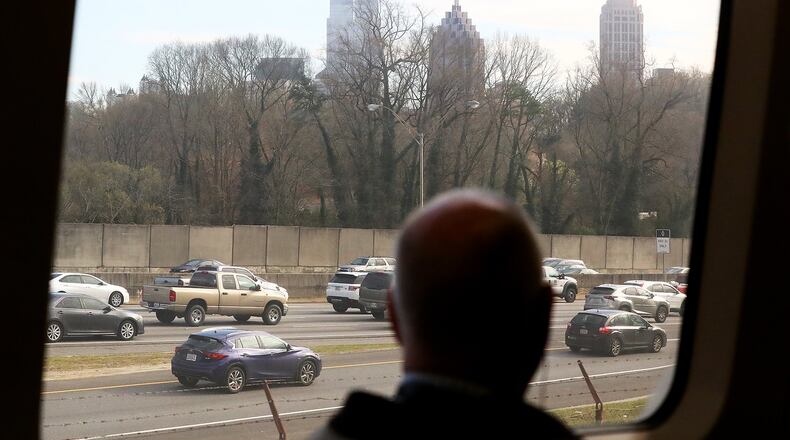On a warm Monday evening, I packed up my computer, crossed the street to the Dunwoody MARTA station and caught the southbound train to my home in East Point – just as I do most nights.
But this night was different.
Days earlier, the MARTA referendum had failed in Gwinnett County, marking the third time in nearly 30 years that Gwinnett voters have decided against expanding public transportation. And so, during the 40-minute train ride home, I began to wonder why.
In a town where it can take one hour and 15 minutes to travel 15 miles, why would public transportation carry such a negative connotation?
Does MARTA really pander to a “bad element,” as one reader wrote on our opinion pages?
Do we metro Atlantans love our cars that much that taking the train, or, God forbid, the bus, is unthinkable?
To help answer these questions, I began documenting my experiences on the train.
My unscientific findings? While the system works, it’s not perfect.
Take that Monday night trip, for instance.
As I stood on the Dunwoody platform, MARTA’s app wasn’t working properly. For some reason, the southbound train wouldn’t appear when I clicked on the “next train arrival.” The electronic board at the station also didn’t show an arrival for the southbound train; it only indicated when the next northbound trains were scheduled to arrive.
Luckily, I use the train frequently enough to know the airport-bound train leaves the Dunwoody station on the “1s.” (I usually catch the 6:41 p.m. or 6:51 p.m. trains.) But what if I weren’t familiar enough with the system?
Once inside the train, two of the adjoining seats were unusable, thanks to a puddle of water that appeared to be caused by condensation from the train’s air-conditioning system. During the ride home, one passenger became a bit unruly – not in a threatening way, mind you, but loud enough to make some passengers feel uncomfortable.
When I finally arrived at the East Point station, someone milling around outside asked me for 50 cents for bus fare.
Despite all of that, the ride was certainly less stressful (and quicker) than sitting in stop-and-go traffic. As the train glided alongside Georgia 400, I couldn’t help but look down on a sea of red brake lights dotting the highway – thanking my lucky stars that I wasn’t among them.
But is that enough to overlook some of MARTA’s shortcomings?
At the same time, are experiences, such as mine that Monday night, enough to dissuade people from ever using mass transit?
In Gwinnett County, the measure would have used proceeds from a new sales tax to fund an expansion of transit services – from a 5-mile rail extension from Doraville to Norcross; to 50 miles of “bus rapid transit” lines; to other additions to bus service.
The proposal failed by a clear margin, 54 percent to 46 percent. Gwinnett also rejected MARTA in 1971 and 1990.
In the weeks leading up to the vote, opponents cited negative factors that could come with MARTA, such as an increase in crime.
“It’s too easy to get in and get out, and do what you need to do, and take what you need to take, and not be found,” one Gwinnett County resident told us. Another person wrote: “While I believe rapid transit helps bring growth and expansion, it also brings crime, ‘affordable’ housing, and marginal businesses that are frequented by people using rapid transit.”
I’ve used the system regularly for the last 10 years. Given my height, folks normally don’t bother me. Even so, in all the years riding the train, I’ve never once felt as if I were in danger. Nor did I get the sense any other passengers were, either.
Once, I did have to use MARTA’s “see and say” app when a group of unruly teenagers were running up and down the car shouting vulgarities and startling some passengers. Unfortunately, MARTA police couldn’t do anything until we reached the next station. By then, the group had already exited the train, laughing loudly as they ran away.
I can see how that could discourage people from using the system.
In Gwinnett County, there were also concerns about the length of time it can take to get from Point A to Point B on public transportation.
That’s a fair point.
Consider the night I took MARTA to a meeting in Tucker. The train trip from Dunwoody to the Lindbergh station to the Doraville station was easy enough, certainly much faster than if I had driven. That was, until I had to jump on the 124 bus from Doraville to Tucker.
Without a dedicated bus line, the 124 traveled the same clogged roads as everyone else. The one-hour 27-minute trip certainly took longer than if I had driven.
There isn’t much MARTA can do about that, but there are steps the agency can take to make the system more user-friendly – and, perhaps, more appealing to those who are reluctant to use mass transit.
First, trains need to be clearly marked. During the week I documented my commute, I noticed issues with signage, such as a northbound train with incorrect markings indicating it was heading to the airport.
The system, I concluded, seems to be built for regular users – not occasional riders.
If MARTA wants people to use the train, it needs to make sure the system is easy to navigate – and even easier to understand.
Secondly, the agency needs to make people feel more secure. I don’t recall seeing a single MARTA police officer riding the train. (The heaviest police presence, it appears, is at the turnstiles or in the parking lots.)
Stephany Fisher, MARTA’s communications manager, acknowledged that there are some instances in which MARTA’s app doesn’t correctly track the location of a train.
The agency plans to upgrade the system so that it can provide users with better arrival predictions, she said. MARTA is also making improvements so that signage on the trains is more accurate.
When it comes to security, Fisher reminded me that, in addition to uniformed patrol officers, MARTA has a number of plain-clothes officers riding the trains, so passengers likely don’t know they’re there. At the same time, the agency’s police department monitors 15,000 cameras, including those positioned on trains and buses.
So, what I have learned by using MARTA?
The system may not be as perfect as its supporters would like you to believe. But it isn’t nearly as bad as its critics maintain.
At some point, Gwinnett County voters will likely go to the polls yet again to decide the fate of MARTA. By then, it will be vital that the system address some of its shortcomings.
Until then, I’ll continue to use the system, which I find (mostly reliable) and safe.
But can MARTA convince others to do the same?
About the Author
Keep Reading
The Latest
Featured



